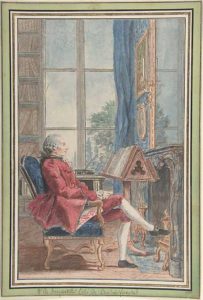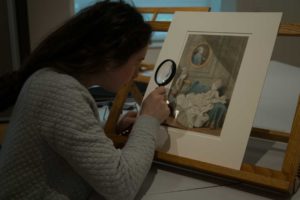Furnishing Carmontelle’s Profile Pictures
EMERGING SCHOLARS > SUMMER RESEARCH GRANTS
Margot Bernstein,
PhD Candidate, Art History, Columbia University
I am the grateful recipient of a 2017 Summer Research Grant from Decorative Arts Trust, which enabled a revelatory cross-country research trip in the service of my doctoral dissertation, “Carmontelle’s Profile Pictures and the Things that Made Them Modern.” My project analyzes roughly 750 portraits on paper by Louis Carrogis, called Carmontelle (1717–1806), an important and prolific visual chronicler of his time. Carmontelle’s depictions of 18th-century celebrities, elites, and servants are instantly recognizable, but they are all too often employed as stock illustrations in histories of the period. My dissertation’s unique treatment of Carmontelle’s portraits as constructions of identity is dependent upon intimate knowledge of the decorative arts objects that Carmontelle’s sitters use to express their sense of self.
My summer trip to the Getty Center in Los Angeles afforded me invaluable firsthand exposure to 18th-century armchairs, desks, mantelpieces, and more. I benefited from the expertise of the Getty’s museum professionals, who generously shared their knowledge with me. I am especially indebted to Charissa Bremer-David, Curator of Sculpture and Decorative Arts, who entertained many questions pertaining to form and function as we moved from the Getty’s furniture storage facility to its period rooms and special exhibition spaces. Ms. Bremer-David gave me literal ‘in-sight’ into the interiors of 18th-century desk drawers and allowed me to get up-close-and-personal with of armchairs’ frames. I analyzed the delicate interior drawers of a toilette table and discovered the capacity of a gilt-bronze molding on a bureau plat to both conceal and offer access to a narrow, hidden compartment.
These observations informed my interpretations of Carmontelle’s sitters in relation to the various types of tables with which they are paired in his portraits. Examination of the carved ornamentation on a gilded French armchair dating to c. 1735–40 shed light upon the correlation between chairs’ ornamentation and function in the context of Carmontelle’s drawings. The extreme level of detail with which the artist described the profusion of decorative objects that surround sitters like Jean-Pierre de Bougainville (shown here) illustrates the increasing significance that furniture carried in 18th-century France and indicates that the arms and legs of the furniture in his portraits deserve as much attention as is traditionally awarded his sitters’ faces.
In addition to studying many of the Getty’s superb examples of 18th-century French furniture, I was also granted access to curatorial and conservation files. These materials were equally instrumental in highlighting the extent to which decorative arts, and the pictures in which they are represented, are imbued with the deepest cultural values of their historical moment. I am indebted to the members of the Decorative Arts Trust for making this opportunity possible.


